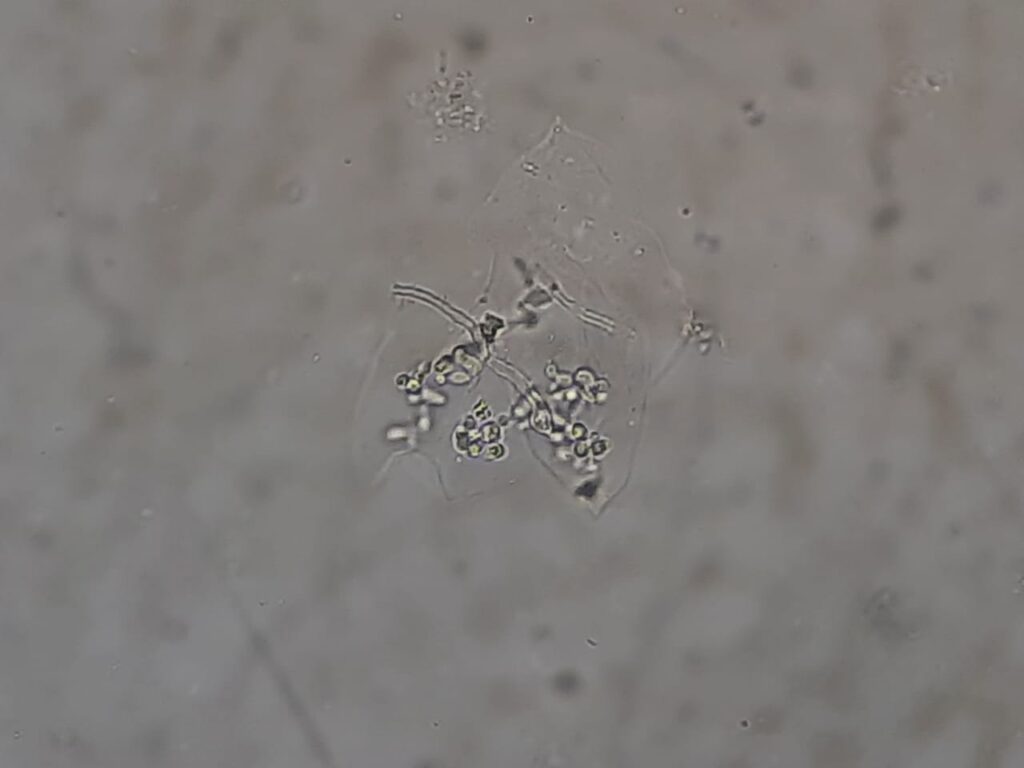Introduction
Table of Contents
KOH mount of sputum is a rapid, direct microscopic technique used to detect fungal elements in the respiratory tract.

A 10–20% Potassium Hydroxide (KOH) solution digests mucus, epithelial cells, and debris in sputum, while preserving the chitin-rich fungal cell walls, making them appear clear, refractile, and easily visible.
This test is important for diagnosing pulmonary fungal infections, especially in patients with:
- Chronic cough or hemoptysis
- Tuberculosis
- Asthma / COPD
- Diabetes
- Cancer or transplant status
- HIV/AIDS or other immunocompromised conditions
It rapidly identifies fungi such as Candida, Aspergillus, Mucorales, and Fusarium
Fungal Elements Observed in Sputum KOH Mount

1. Yeast Cells
- Round/oval, refractile bodies
- May show budding (blastoconidia)
- Seen in Candida species (e.g., C. albicans, C. tropicalis).
2. Pseudohyphae
- Elongated, “sausage-like” structures with constricted septa
- Indicative of invasive or active Candida infection
- More clinically significant than isolated yeast cells
3. True Hyphae
a. Aspergillus species
b. Mucorales (Mucor, Rhizopus, Lichtheimia)
- Broad, ribbon-like, non-septate hyphae
- Irregular branching
- Indicates mucormycosis — a medical emergency
c. Fusarium species
- Septate hyphae
- May show banana-shaped fusiform conidia
4. Conidia / Spores
- Small, refractile, round/oval structures
- Seen in Aspergillus, Penicillium, or environmental molds
- Require clinical correlation to distinguish infection from contamination
5. Pneumocystis jirovecii (rarely visible in KOH)
- Foamy alveolar material
- Better detected by GMS, Giemsa, and DFA
Applications

1. Rapid Screening Test
Immediate bedside/bench-side detection of fungal elements before culture or molecular testing.
2. Diagnosis of Pulmonary Fungal Infections
Useful for identifying:
- Aspergillosis
- Candidiasis
- Mucormycosis
- Fusariosis
3. Critical Care Utility
Essential in ICU, diabetic, oncology, and transplant patients suspected of fungal pneumonia.
4. Guides Early Antifungal Treatment
Quick detection of hyphae allows clinicians to start urgent antifungal therapy, especially in mucormycosis and invasive aspergillosis.
5. Supports and Complements Other Tests
Correlates with:

6. Useful in Co-infection Screening
Helps detect fungal infections co-existing with tuberculosis or HIV.
Keynotes

- KOH concentration: 10–20%, clears background for fungal visibility.
- Fungal elements appear clear, refractile, and well-defined.
- Rapid but non-specific → requires culture or molecular confirmation.
- Interpretation needs expertise to avoid confusion with mucus threads, artifacts, or fibers.
- Essential for diagnosing aspergillosis, mucormycosis, candidiasis, and mixed infections.
- Best used as part of a diagnostic algorithm, not as a standalone test.
Further Readings
- https://flabslis.com/blogs/koh-test-procedure
- https://www.ijorl.com/index.php/ijorl/article/download/2384/1322/10157
- https://mediscanlab.com/koh-preparation-for-fungal-elements
- https://www.1mg.com/labs/test/koh-staining-sputum-35070
- https://commons.wikimedia.org/wiki/File:Fungal_elements_in_KOH_mount_of_Sputum.jpg
- https://pmc.ncbi.nlm.nih.gov/articles/PMC6414738/
- https://fac.ksu.edu.sa/sites/default/files/fungal_structure.pdf
- https://www.sciencedirect.com/science/article/pii/B9780323957359000115
- https://prepp.in/question/hyphae-are-6448f58e128ecdff9f52205c
- https://pmc.ncbi.nlm.nih.gov/articles/PMC3019347/
- https://www.ganeshdiagnostic.com/fungus-stain-bronchial-secretions
